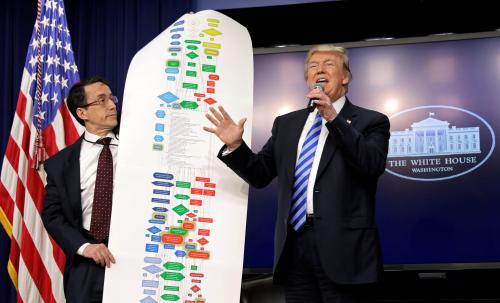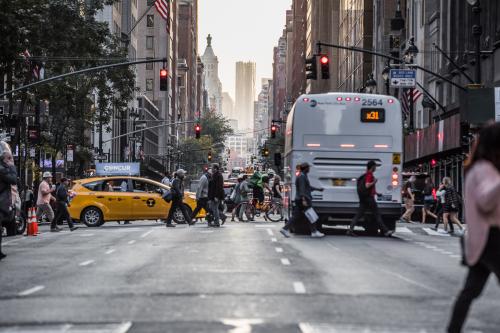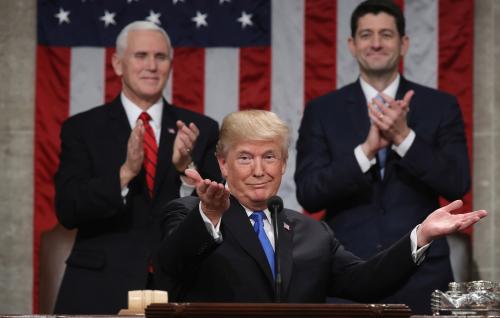Rebuilding America was always a central part of Donald Trump’s political ambitions. His affirmative message and decades of real estate experience created a palpable sense among both the general public and the media that the President would bring a major infrastructure push to Washington. But from the very first months of his administration, it became clear the new White House team wasn’t ready with tangible ideas to match Trump’s grandiose rhetoric. With multiple missed deadlines and no official documents since the last budget release, the wait for the plan’s grand reveal stretched for months with seemingly no end in sight.
The wait is finally over—and it doesn’t feel worth it.
Rather than establishing a clear long-term vision for the country’s infrastructure that supports a more competitive and inclusive economy, the proposal is mostly a vehicle to indiscriminately boost spending. Even worse, the proposed cuts elsewhere in the FY 2019 Budget mean the administration is effectively asking everyone else – especially cities and states – to do nearly all the spending all while still claiming credit for new investments. There are certainly commendable elements within the 53 pages, but the core programs include too much cynicism and too little leadership. It’s a missed opportunity.
The first bit of cynicism is how the proposal looks to address infrastructure challenges across different parts of the country.
For example, through the creation of an Infrastructure Incentives Program, the proposal is skewed to reward high-growth places. Using a $100 billion pot, but capping the federal match at 20 percent, the program would reward states and localities based overwhelmingly on their ability to develop new revenue sources, whether via higher taxes, shifting current spending, or attracting private capital. This could work in metropolitan areas with economic tailwinds: think places like the Bay Area, Seattle, and Austin. But economic growth is inconsistent across the country, with many sizable U.S. counties and entire metropolitan areas facing slow population growth, stalled wage growth, and fiscal stress. This program won’t work for them.
At the same time, however, the proposal also calls for a $50 billion Rural Infrastructure Program, with questionable aims. Functioning like a formula block grant to states based on their national share of rural population and lane miles, it would essentially give governors carte blanche to invest in their rural counties, or places of less than 50,000 people. Since Trump’s earlier infrastructure proposal during his campaign got hammered for its inability to recognize that private financing may not be attracted to rural infrastructure projects, this feels like an outsized political response to placate U.S. Senators from rural states.
The administration essentially created a system that could leave many metropolitan areas and entire states without federal infrastructure support. It’s mute about the fiscal capacity issues many places face. Some communities live in states with self-help limitations from their state governments; they can’t simply raise new revenue. Many public water utilities failed our high-level fiscal stress test. Many municipalities still have not seen their general funds return to pre-Great Recession levels. And to top it off, raising new revenue also got more expensive due to changes in the new tax law, such as capped property tax deductions. Considering that state and local governments already do the bulk of public investing in infrastructure, this proposal must feel like the potential loss of a once trusted partner.
Adding to the cynicism, of course, is how the rest of the budget handles infrastructure. It’s one thing for the administration to promise $200 billion in new spending, knowing the bulk of their proposed $1.5 trillion will be sourced from states and localities. It’s quite another to propose roughly $200 billion in cuts to current infrastructure programs to offset the new federal spending. The response to this has been swift from the political left, but it has also been telling to not yet observe defense from the political right. Further, the proposal could also attract new adversaries. If many cities and counties oppose the new Incentives Program, the proposed budget cuts will enrage a different set of actors, including transit agencies who could be deeply impacted.
Of course, you can find great irony in all this. One of the main ways localities generate new revenue is through ballot measures to build fixed route transit—and all those voter-approved plans count on support from a federal program the administration proposes eliminating.
Unfortunately, the proposal’s cynicism is matched by a lack of leadership. None of these programs include a point of view. Compared to the grand programs of our past—the New Deal’s pursuit of electrical and telephone expansions; the national interstate highway system; water investments in the 1970s—there is no statement about what kind of economy we should build. Infrastructure isn’t just an enormous collection of concrete and pipes, or some loose problem set to be solved by higher macro spending. And even if it was, with extremely low unemployment and rising interest rates, now is not the ideal time to initiate a spending binge.
Compared to the grand programs of our past—the New Deal’s pursuit of electrical and telephone expansions; the national interstate highway system; water investments in the 1970s—there is no statement about what kind of economy we should build.
The country has tangible infrastructure needs. While federally-supported roads are in good shape, our local roads could use help. Vital transit agencies, especially older systems, demand modernization. Water pipes are breaking down in many places and water service is not yet affordable to all. Broadband does not yet reach every corner of rural America, but nor are the majority of low income households subscribed to a broadband connection. And we live in an age of great infrastructure opportunity, where new digital technologies will enable us to modernize our infrastructure as we rebuild it.
We need the federal government to address these challenges head on, using its vast resources and unparalleled personnel to sharpen policy design and invest alongside its peers. Instead, we received a proposal that had little to say about how to make our country more competitive or more inclusive.
Now that the proposal is live, this is likely only the beginning of six-plus months of infrastructure debate in Washington—and the degree of difficulty only grows from here. First, multiple committees in the House and Senate will need to come to consensus around infrastructure policy. Since members haven’t yet proposed any, that leaves significant work to even introduce and debate bills.[1] Second, Congress will need to find the money to pay for any new programming, whether that’s making cuts to current programs, raising taxes, borrowing more, or (more likely) some combination of all three. Keep in mind, Congress already has ongoing, tense debates around issues like raising the gas tax. Finally, Senate rules necessitate bipartisan support to pass any bill. If the Democratic Party doesn’t like what’s being proposed—whether for conceptual or political reasons—the whole process could stall.
Based on this new proposal and what Congress still needs to do, it’s hard to hold much hope for a massive infrastructure bill that will match the President’s grandiose language. Instead, if we’re going to get any new laws before the midterm elections, expect boutique reforms around permitting, federal credit programs, and project financing. They may not be as grandiose, but they can attract bipartisan support and won’t leave any places out in the cold.
Instead, we expect cities and states to keep leading the way—by building greater community support, by executing new project designs, and by developing stronger partnerships—as Washington decides where to go next.
[1] There are multiple reauthorization bills currently under formal debate or with introduced language, including aviation and water resources. But there are no bills that reflect the spirit of “new comprehensive infrastructure” programming.
The Brookings Institution is committed to quality, independence, and impact.
We are supported by a diverse array of funders. In line with our values and policies, each Brookings publication represents the sole views of its author(s).







Commentary
The President’s infrastructure proposal misses the mark: Too much cynicism, too little leadership
February 13, 2018